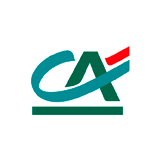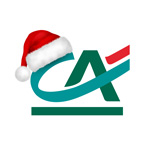Agroapp, April 2025
Nataliia Porvina, Head of Agribusiness Support and ESG Department of Credit Agricole
The banking system and agrarian sector have gradually adjusted to work in the wartime. Financing of the spring sowing-2025 is underway. Agribusinesses apply for loans to replenish working capital and take out loans for development and upgrading their machinery fleet in order to be competitive and maintain their financial stability in the future. This is also facilitated by partner programmes with international financial institutions such as the EBRD and IFC, which allow the purchase of fixed assets on favourable terms.
Agricultural lending is part of our Group’s DNA – we are committed to supporting agribusiness, which drives the economy and generates a significant share of Ukraine's foreign exchange earnings. Certainly, there are significant financing risks in the wartime, but we are prepared to meet the demand for financing more actively than we did at the beginning of the war.

On the dynamics of farmers' financing in 2024
In 2023-2024, banks' loan portfolios stabilised. According to the NBU, as of 31 December 2024, the total loan portfolios of agricultural producers amounted to UAH 114.3 billion (almost at the level of the previous year). Demand for investment financing with longer loan maturities has increased, while demand for working capital has decelerated. The main reason for this is the increased profitability of Ukrainian farmers.
At the end of 2024, we saw a significant improvement in the financial position of agricultural producers. This was due to the recovery of prices for crop production and the stable operation of the Black Sea ports, which ensured regular exports of food. In addition, in 2024, agricultural producers received good yields of winter crops (winter wheat and winter rapeseed). At the same time, it is worth noting that the average yield of spring grains and oilseeds, in particular corn and sunflower, decreased significantly. However, for most agricultural producers, a significant increase in prices for these crops allowed them to cover lower gross production volumes. Thus, at the beginning of 2025, average domestic prices in hryvnia for corn and barley were 80% higher than the previous year. Wheat prices rose by 75% on average, while sunflower and rapeseed prices increased by 80% and 65% respectively.
Price dynamics for milk producers were also quite positive. In 2024, milk prices were on average almost 30% higher than in 2023. Despite a decline in early 2025, milk prices are still significantly higher than last year.
The situation in the pork market has changed due to rising prices for key feed ingredients and an increase in meat supply. Agricultural producers that do not produce their own feed and its components showed a significant decline in gross margins compared to 2023 (often the gross margin was negative). The decline in margins in pork production and increased biosecurity risks (the spread of ASF virus) forced some agricultural producers to suspend production or increase slaughter in the late 2024, which led to a reduction in the number of animals. This is already having a positive impact on the livestock market, with prices starting to recover.
Overall, in 2024, a significant number of agricultural producers managed to make a profit and improve their financial performance. Positive dynamics in crop production drove interest in purchasing agricultural machinery. In addition, the demand for investment lending rose among many agricultural producers. Agricultural machinery sales picked up in 2024, with positive dynamics also observed in 2025. Machinery leasing is also gaining momentum. At Credit Agricole, we also provide leasing services with leading manufacturers and distributors: John Deere, Fendt, Wielton, MAN, Massey Ferguson, Lemken and others.
It should be noted that the customer interest in investing in energy autonomy has become quite lively. The market is witnessing customer interest in solar panels and the construction of biogas plants. Sustainable development and promotion of ESG principles of corporate governance is an important area of work for Credit Agricole.
Areas of agribusiness most actively applying for loans
Grain and oilseed producers are traditionally the largest consumers of bank loans. During the sowing campaign, we see a traditional increase in demand for working capital to purchase seeds, plant protection products and mineral fertilisers. Quite often, agricultural producers use bank partner programmes with leading players in the market for these products. The list of such programmes is constantly expanding, and more and more banks are actively developing this area.
In terms of investment financing, agricultural producers specialising in milk production are currently the most active in demonstrating their investment appetite. As for crop production, in this sector there is a strong demand for the renewal of machinery and tractors and for bank financing. Demand is particularly strong among customers who have not updated their machinery for a long time.
For the second consecutive year, Credit Agricole is the best bank for agribusiness according to the business magazine ‘TOP-100. Ratings of the largest’ and Delo.ua.
The bank offers over 60 partner programmes, including working capital financing:
- Lending costs from 0.01% per annum in UAH.
- The loan term is up to 12 months.
- Reduced interest rate for loans without collateral.
- Partner programmes with Syngenta, Lidea, ADAMA, TIMAC AGRO, Corteva and other market leaders.
Would you like to receive financing on favourable terms? Apply for a loan online and Credit Agricole expert will give you a call: https://credit-agricole.ua/questionaire/finansovi-rishennya-dlya-posivnoyi


 Useful information
Useful information
 Useful information
Useful information
 Useful information
Useful information
 Useful information
Useful information
 Useful information
Useful information
 Useful information
Useful information
 Useful information
Useful information
 Useful information
Useful information
 Useful information
Useful information
 Useful information
Useful information
 Useful information
Useful information
 Useful information
Useful information
 Useful information
Useful information
 Useful information
Useful information
 Useful information
Useful information







